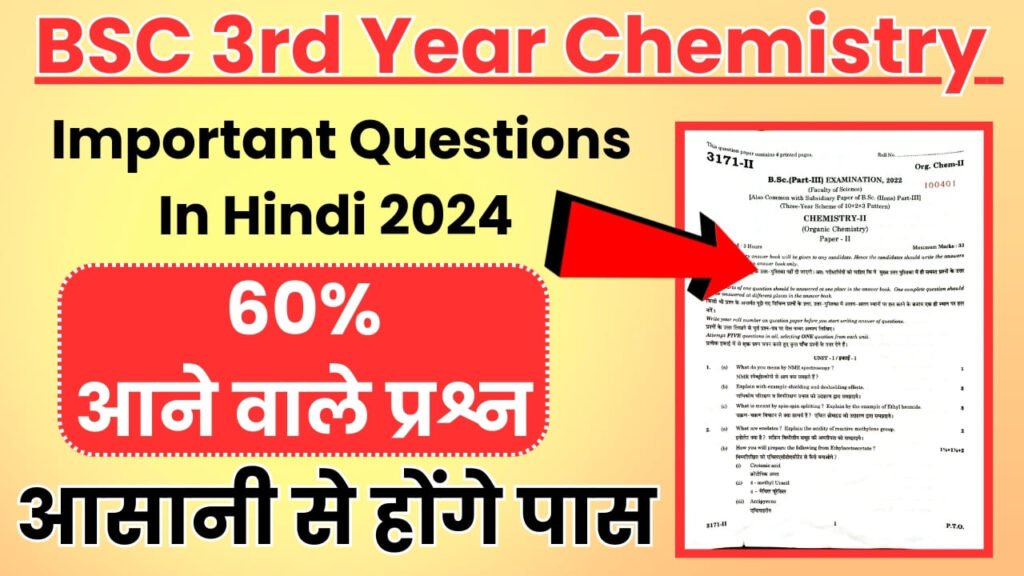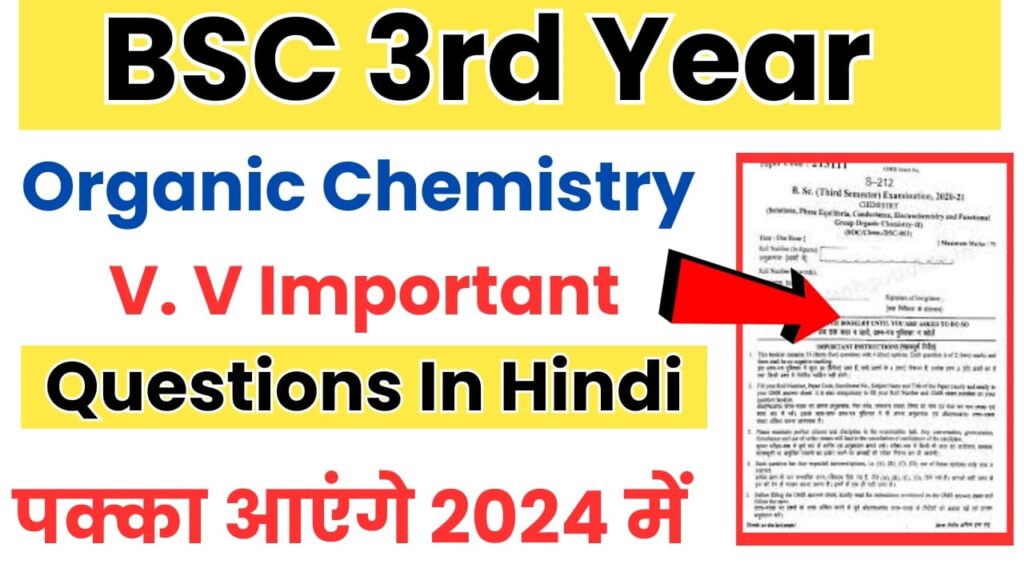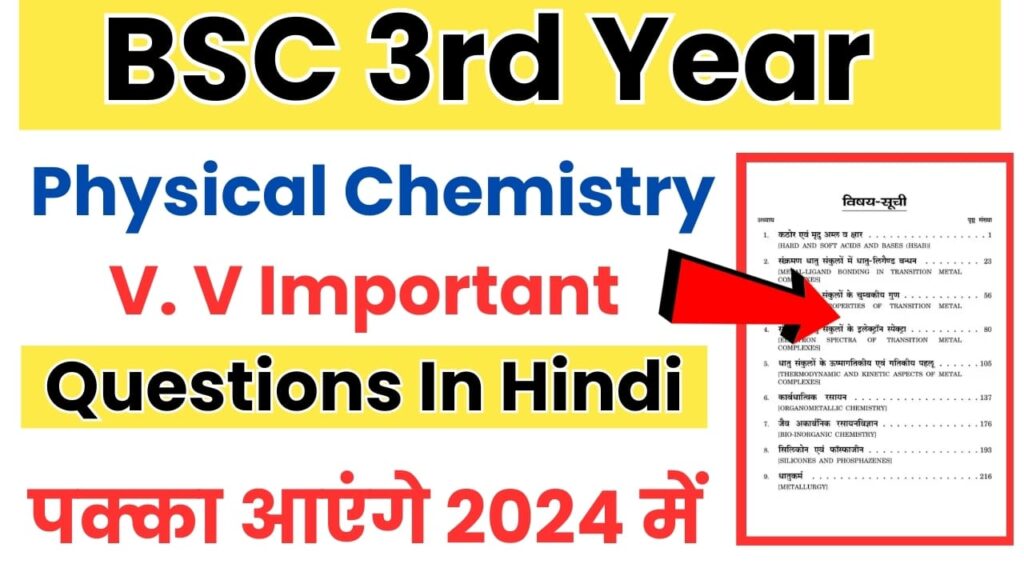नमस्कार साथियों क्या आप जानना चाहते है BSC 3rd Year Chemistry Important Questions In Hindi 2024 के बारे में? दोस्तों आपका स्वागत है इस लेख में, हम आपको BSC 3rd Year Chemistry Important Questions In Hindi के साथ BSc 3rd year inorganic chemistry important questions, BSc 3rd year organic chemistry important questions, BSc third year physical chemistry important questions 2024 के बारे में सब कुछ बताएंगे। जैसा कि आप जानते हैं Chemistry एक बहुत ही दिमाग लगाने वाला subject है, तो इस लेख में हमने BSC 3rd Year Chemistry Important Questions इकट्ठा किया है जो कि आपको पढ़ने में मदत करेंगे अगर आप इस लेख में बताए हुए Important Questions को एक बार रट लेंगे तो आप समझ लो 60% syllabus cover हो जाएगा, तो BSC 3rd Year Chemistry Important Questions In Hindi की पूरी सूची पढ़ने के लिए इस लेख को अंत तक जरूर पढ़ें ।

यह BSc 3rd Year Chemistry के महत्वपूर्ण प्रश्न 2024 प्रतिष्ठित संस्थानों के अनुभवी शिक्षकों द्वारा तैयार किए गए हैं, इन प्रश्नों के पेपर में आने की अधिक संभावना है, इसलिए इन्हें अच्छी तरह से तैयार करें।
Contents
BSC 3rd Year Chemistry Important Questions In Hindi

Q1: ऐरोमैटिक यौगिकों की सुगंधिता के प्रमुख कारण को समझाइए। (Explain the main reason for the aromaticity of aromatic compounds.)
Q2: SN1 और SN2 क्रियाविधियों के बीच प्रमुख अंतर को सूचीबद्ध कीजिए। (List the key differences between SN1 and SN2 reaction mechanisms.)
Q3: कार्बोहाइड्रेट और उनके जैविक महत्व को संक्षेप में समझाइए। ( Briefly explain carbohydrates and their biological importance.)
Q4: लैंथनाइड संकुचन क्या है और इसके गुणों पर इसका क्या प्रभाव पड़ता है? (What is lanthanide contraction and how does it affect their properties?)
Q5: राउल्ट का अभिगमन नियम किसे कहते हैं और यह आदर्श विलयन पर कैसे लागू होता है? (What is Raoult’s law of vapor pressure and how does it apply to ideal solutions?)
Q6: संघर्षण गुणांक (Friction coefficient) और विस्कोसिटी (Viscosity) में क्या संबंध है? (What is the relationship between the friction coefficient and viscosity?)
Q7: प्रथम और द्वितीय ऑर्डर अभिक्रियाओं के वेग स्थिरांक (Rate constant) में क्या अंतर है? (What is the difference between the rate constants of first and second order reactions?)
Q8: समन्वय यौगिकों के नामकरण के लिए IUPAC नियमों को संक्षेप में बताइए। ( Briefly explain the IUPAC rules for naming coordination compounds.)
Q9: p-ब्लॉक तत्वों की ऑक्सीकरण अवस्थाएँ उनकी स्थिरता को कैसे प्रभावित करती हैं? (How do the oxidation states of p-block elements affect their stability?)
Q10: धातु जैसे आयनिक संघटन के विश्लेषण के लिए कौन-कौन से विधि का उपयोग किया जा सकता है? (Which methods can be used for the analysis of metallic compounds’ coordination?)
Q12: वायलेटिक रीयकोटर क्या हैं? (What are violettae-coat?)
Q13: उत्पादक संवेदनशीलता क्या है? (What is catalytic activity?)
Q14: प्रतिस्थापन आयन क्या है? (What is a replacement ion?)
Q15: विलयन निर्धारण क्या है और इसका क्या महत्व है? (What is titration and what is its significance?)
Q10: इसोप्रोपिल आल्फा डायमेथिल अर्सीन क्या है? (What is isopropyl alpha dimethyl arsenic?)
Q11: ऑक्टेटिंग एजेंट क्या है? (What is octeting agent?)
Q12: सामाजिक पर्यावरण में मुक्त वायु या अस्तित्व और इसके प्रभाव पर चर्चा करें। (Discuss free air or existence in the social environment and its effects.)
Q13: परमाणु यौगिकी में अवकाश नियम क्या है? (What is the Aufbau principle in atomic chemistry?)
Q14: निम्नलिखित में से कौन-सा धातु विद्युत चुंबकीय है? (Which of the following metals is ferromagnetic?)
Q15: डेल्टा G° का महत्व क्या है? (What is the significance of Delta G°?)
Q16: धातु यौगिक आयनिक संरचना की जांच के लिए कौन-कौन से साधनों का उपयोग किया जा सकता है? (Which methods can be used for the investigation of metallic compound ionic structure?)
Q17: डी और डी-डैश की समरूपता क्या है? (What is the similarity between D and D-dash?)
Q18: आप विद्युत चुंबकीय द्रव्यों के प्रकार क्या हैं? (What are the types of ferromagnetic substances?)
Q19: बिना बाह्य अद्यतन के सुल्फर का नाभिकीय संरचन क्या है? (What is the nuclear structure of sulfur without external update?)
Q20: प्रकाश के प्रकार क्या हैं? (What are the types of light?)
Q21: संक्षिप्त रूप में रेखांकन क्या है? (What is line rearrangement in brief?)
Q22: धातु आयनिक रेखांकन में अतिक्रमण क्या है? (What is transgression in metallic ionic rearrangement?)
Q23: सामान्य अवधारणा में, संक्रिया अंश क्या है? (In general concept, what is reaction component?)
Q24: जानकारी विस्तार में धातुओं के यौगिक आयनिक संरचन का विश्लेषण कैसे किया जाता है? (How is the detailed analysis of metallic compound ionic structure done?)
Q25: प्राथमिक संघटन में विद्युत आयनों की संख्या क्या होती है? (What is the number of electric ions in primary structure?)
Q26: परमाणु यौगिकी में संरचना सार क्या है? (What is the gist of the structure in atomic chemistry?)
Q27: संघटक आयनों की अवधारणा क्या होती है? (What is the concept of constituent ions?)
Q28: आयनिक संरचन के लिए विश्लेषण विधियाँ क्या हैं? (What are the analysis methods for ionic structure?)
Q29: तरल आयनिक विलयन क्या है? (What is the liquid ionic dissolution?)
Q30: संयोज्य पदार्थों के लिए आयनिक संरचन के लिए विश्लेषण विधियाँ क्या हैं? (What are the analysis methods for ionic structure in coordinated substances?)
Q31: आयनिक संरचन की प्रमुखता क्या है? (What is the predominance of ionic structure?)
Q32: इसका क्या अर्थ है जब हम कहते हैं कि धातुओं में इलेक्ट्रॉन के स्थिति अशांत है? (What does it mean when we say the electron state in metals is turbulent?)
Q33: अवस्थान प्रश्न क्या हैं? (What are the position questions?)
Q34: क्षुधा धाराएं क्या हैं? (What are the hunger streams?)
BSC 3rd Year Chemistry Questions with Answers

Q1: प्रयोगशाला के अनुसार विज्ञानी किसे कहते हैं?
Answer: प्रयोगशाला के अनुसार विज्ञानी वह व्यक्ति है जो वैज्ञानिक अध्ययन और अनुसंधान करता है।
Q2: धातु और अधातु के बीच क्या अंतर है?
Answer: धातु एक चुंबकीय पदार्थ है जो धातुओं में विद्यमान होता है, जबकि अधातु धातुओं से अलग हैं।
Q3: संघटन तंत्र क्या है?
Answer: संघटन तंत्र एक विशेष प्रकार की केमिस्ट्री है जो आयनिक संरचनाओं को अध्ययन करती है।
Q4: आयनिक और अयानिक योजनाएँ क्या हैं?
Answer: आयनिक योजनाएँ वे योजनाएँ हैं जो आयनों के बीच बनी होती हैं, जबकि अयानिक योजनाएँ आयनों के साथ नहीं होती हैं।
Q3: डिस्टिलेशन क्या है?
Answer: डिस्टिलेशन एक प्रकार की शुद्धि प्रक्रिया है जो एक द्रव्य को उसके अधिक उबालने पर अलग धातुओं में विभाजित कर देती है।
Q4: धातु संश्लेषण क्या है?
Answer: धातु संश्लेषण एक प्रकार की केमिस्ट्री है जो दो या दो से अधिक धातुओं के बीच के आयनिक रिश्तों को अध्ययन करती है।
Q5: ऑक्सिडेशन और रिडक्शन क्या है?
Answer: ऑक्सिडेशन एक प्रकार की रासायनिक प्रक्रिया है जिसमें एक पदार्थ ऑक्सीजन के साथ या बिना ऑक्सीजन के रिएक्ट करता है, जबकि रिडक्शन में इलेक्ट्रॉन ग्रहण होता है।
Q6: धातु में उपचय क्या है?
Answer: धातु में उपचय एक प्रकार की विद्युत परिणामकारीता है जो धातु की विद्युत स्पर्धा को विश्लेषित करती है।
Q7: अधिष्ठानिक द्रव्य क्या है?
Answer: अधिष्ठानिक द्रव्य एक ऐसा द्रव्य है जिसमें किसी अन्य द्रव्य को राख किया जा सकता है और जो अपनी संरचना और गुणों को बनाए रखता है।
Q8: संवेदनशीलता क्या है?
Answer: संवेदनशीलता एक पदार्थ की क्षमता है जो रिएक्ट करने के लिए अन्य पदार्थों के साथ आमंत्रित होता है।
Q9: सामान्य अवधारणा में, रसायन विज्ञान के किस क्षेत्र में अध्ययन किया जाता है?
Answer: रसायन विज्ञान के क्षेत्र में द्रव्यों की संरचना, गुण, प्रक्रियाएं, और उनके रिएक्टिविटी का अध्ययन किया जाता है।
Q10: प्रायोगिक कैलिब्रेशन क्या है?
Answer: प्रायोगिक कैलिब्रेशन एक प्रकार की तकनीक है जिसमें उपकरण या मापक की समीक्षा या समायोजन की जाती है।
Q11: प्रतिक्रिया दर क्या है?
Answer: प्रतिक्रिया दर रिएक्टन की गति को निर्दिष्ट करती है, और यह रिएक्शन के अंतर्गत कितना समय लेता है।
Q12: विलयन क्या है?
Answer: विलयन एक प्रकार की रसायनिक प्रक्रिया है जिसमें एक पदार्थ अन्य द्रव्यों में विघटित हो जाता है।
Q13: परमाणु आयन क्या है?
Answer: परमाणु आयन एक पदार्थ का केंद्रिक धारावाहिक है, जिसमें न्यूक्लियस और इलेक्ट्रॉन होते हैं।
Q14: उच्च संरचनात्मक आयन क्या है?
Answer: उच्च संरचनात्मक आयन एक प्रकार का आयन है जो अपने आसपास के पर्यावरण को प्रभावित कर सकता है।
Q15: न्यूक्लियर व्यवस्थितता क्या है?
Answer: न्यूक्लियर व्यवस्थितता एक पदार्थ की अणु के नाभिकीय आयनों के संरचन का आकलन करती है।
Q16: अधिस्थानिक समीकरण क्या है?
Answer: अधिष्ठानिक समीकरण एक रासायनिक समीकरण है जो एक रासायनिक प्रक्रिया की सारणी या मॉलेक्युलर संरचना को दर्शाता है।
Q17: इंटरमोलीक्युलर बाँध क्या है?
Answer: इंटरमोलेक्युलर बॉंड एक पदार्थ के बीच केमिकल बाँध है जो उनकी संरचना को बनाए रखने में मदद करता है।
Q18: धातु-आयन समीकरण क्या है?
Answer: धातु-आयन समीकरण एक आयनिक संश्लेषण प्रक्रिया है जो धातुओं के बीच के आयनिक संरचना को वर्णन करता है।
BSC 3rd Year Organic Chemistry Important Questions In Hindi

Q1: कैर्बनिक रासायनिक यौगिकों की परिभाषा और उनकी विशेषताएँ क्या हैं? (What is the definition and characteristics of organic compounds?)
Q2: आइसोमेरिज़म क्या हैं और उनके प्रकार कैसे होते हैं? (What are isomerism and its types?)
Q3: बेंजीन के अमाइन क्या होते हैं और उनके उपयोग? (What are benzene amines and their uses?)
Q4: सर्जरी विज्ञान में ऑर्गेनिक रसायनों का उपयोग (Use of organic compounds in surgery)
Q5: ऐल्काइन और इल्केन के मुख्य संयोजन क्या हैं? (What are the main reactions of alkanes and alkenes?)
Q6: ऑल्डीहाइड और केटोन के प्रकार और उनके विशेषताएँ (Types and characteristics of aldehydes and ketones)
Q7: कार्बनिल यौगिक की अलग-अलग विधियाँ (Different methods of carbon compounds)
Q8: आरेन या बेंजीन के डाईजोटाइजेशन (Diazotization of aryl or benzene)
Q9: कार्बन के चुंबकीय गुण (Magnetic properties of carbon)
Q10: आलडेहाइडों और केटोनों की प्रमुख विशेषताएँ (Major characteristics of aldehydes and ketones)
Q11: ऐल्काइन का उत्पादन और उपयोग (Production and uses of alkanes)
Q12: रिक्त केटोनिक उत्पादन और उनके उपयोग (Empty ketonic production and its uses)
Q13: अल्काइन और इल्केन के प्रमुख विशेषताएं (Major characteristics of alkanes and alkenes)
Q14: बेंजीन के प्रमुख रिएक्शन और उपयोग (Major reactions and uses of benzene)
Q15: उपनिर्मित प्रोडक्ट्स की परिभाषा (Definition of derived products)
Q16: कार्बनिक रसायनों के उपयोग (Uses of organic compounds)
Q17: कार्बनिक यौगिकों की रासायनिक विशेषताएँ (Chemical properties of organic compounds)
Q18: सर्जरी विज्ञान में यौगिकों का उपयोग (Use of compounds in surgery)
Q19: ऑल्डिहाइडों और केटोनों के लिए उपनिर्मित उत्पादों के प्रमुख विशेषताएं (Major characteristics of derived products for aldehydes and ketones)
Q20: आर्गेन का उत्पादन (Production of argon)
Q21: अल्काइन और इल्केन के उत्पादन की विधियाँ (Methods of production of alkanes and alkenes)
Q22: सर्जरी में ऑर्गेनिक रसायनों के उपयोग (Uses of organic compounds in surgery)
Q23: कार्बनिक यौगिकों की खोज (Discovery of organic compounds)
Q24: बेंजीन के नाइट्रो कॉम्पाउंड्स (Nitro compounds of benzene)
Q25: कार्बनिक यौगिकों की प्रमुख विशेषताएँ (Major characteristics of organic compounds)
Q26: आल्डिहाइडों और केटोनों के लिए उत्पादित उत्पादों के प्रमुख विशेषताएँ (Major characteristics of produced products for aldehydes and ketones)
Q27: ऑल्डीहाइड्स और केटोन्स के उत्पादित प्रोडक्ट्स (Produced products of aldehydes and ketones)
Q28: सर्जरी में ऑर्गेनिक यौगिकों का उपयोग (Use of organic compounds in surgery)
Q29: कार्बनिक यौगिकों के उत्पादन (Production of organic compounds)
Q30: ऐल्काइन और इल्केन के प्रमुख विशेषताएं (Major characteristics of alkanes and alkenes)
BSC 3rd Year InOrganic Chemistry Important Questions In Hindi

Q1: प्रधान उत्पाद की परिभाषा क्या है? (What is the definition of a main product?)
Q2: उत्पाद के प्रकार क्या हैं? (What are the types of products?)
Q3: उत्पादन प्रक्रिया की परिभाषा क्या है? (What is the definition of a production process?)
Q4: धातु और अधातु के बीच क्या अंतर है? (What is the difference between metal and non-metal?)
Q5: विलयन की परिभाषा क्या है? (What is the definition of fusion?)
Q6: गैलिना क्या है? (What is Galena?)
Q7: संगमरमर का सृजन कैसे होता है? (How is marble formed?)
Q8: क्या है मृदा तत्व? (What are soil elements?)
Q9: अधातु की परिभाषा क्या है? (What is the definition of a non-metal?)
Q10: गुण क्या होते हैं? (What are properties?)
Q11: ग्रूप वाले तत्व कौन कौन से हैं? (Which elements are in the group?)
Q12: आवर्त सारणी क्या है? (What is the periodic table?)
Q13: बीच तत्व कौन से होते हैं? (Which are the transition elements?)
Q14: क्या है धातु की परिभाषा? (What is the definition of a metal?)
Q15: धातुओं के गुण क्या होते हैं? (What are the properties of metals?)
Q16: अधातुओं के गुण क्या होते हैं? (What are the properties of non-metals?)
Q18: धातु-अधातु का यौगिक अंतर क्या है? (What is the chemical difference between metal and non-metal?)
Q19: उत्पाद के प्रकार क्या हैं? (What are the types of products?)
Q20: विलयन की परिभाषा क्या है? (What is the definition of fusion?)
Q21: क्षारीय धातु क्या है? (What are alkali metals?)
Q22: गैलिना क्या है? (What is Galena?)
Q23: जंगल की शिला क्या है? (What is the stone of the jungle?)
Q24: अधातु की परिभाषा क्या है? (What is the definition of a non-metal?)
Q25: धातु की परिभाषा क्या है? (What is the definition of a metal?)
Q26: सूचीकृत धातु क्या हैं? (What are the listed metals?)
Q27: प्रथम, द्वितीय, तृतीय धातु क्या हैं? (What are primary, secondary, and tertiary metals?)
Q28: आवर्त सारणी क्या है? (What is the periodic table?)
Q29: उत्पाद के प्रकार क्या हैं? (What are the types of products?)
Q30: क्षारीय धातु क्या होते हैं? (What are alkali metals?)
Q31: धातु का यौगिक गुण है। (Metal is a chemical property.)
BSC 3rd Year Physical Chemistry Important Questions In Hindi

Q1: थर्मोडायनामिक्स में प्राइमरी और सेकंडरी तरलता क्या होती है? (What are primary and secondary fluidity in thermodynamics?)
Q2: गेलवानिक क्षमता क्या है? (What is galvanic capacity?)
Q3: थर्मोडायनामिक के प्रमुख नियमों को समझाएं। (Explain the major laws of thermodynamics.)
Q4: एंट्रॉपी क्या है और इसके प्रकार क्या होते हैं? (What is entropy and what are its types?)
Q5: लेचाटलिये प्रदिष्ट कीजिए। (Define Le Chatelier’s principle.)
Q6: गेल्वानिक तथा नॉन-गेल्वानिक क्षमता के बीच अंतर क्या है? (What is the difference between galvanic and non-galvanic capacity?)
Q7: क्वांटम संख्या क्या होती है? (What are quantum numbers?)
Q8: प्रत्यक्ष और अप्रत्यक्ष बंधन का अंतर क्या है? (What is the difference between direct and indirect bonding?)
Q9: स्थिर आवेशित और गतिशील आवेशित तत्वों का मतलब बताएं। (Explain the meaning of stable and dynamic adsorbed elements.)
Q10: निष्क्रियता सीमा क्या है? (What is the threshold of inactivity?)
Q11: डी-ब्लॉक तत्वों के लिए कार्बनिक अम्ल क्या है? (What is carbonyl acid for D-block elements?)
Q12: विकेंद्रित अणु क्या हैं? (What are excited atoms?)
Q13: वन द्विघटकीय और द्विघटकीय यौगिक निर्माण के लिए नियम क्या हैं? (What are the rules for constructing mono- and bi-functional compounds?)
Q14: संधारित उत्तेजित स्थिति में रासायनिक प्रक्रियाएं कैसे होती हैं? (How are chemical processes in equilibrium excited states carried out?)
Q15: उपनात्मिक तथा परमानु चुम्बकीय प्रतिक्रिया के अवस्थाएँ बताएं। (Explain the states of sub-nuclear and paramagnetic reactions.)
Q16: एनजीओ का परिभाषा और उसकी उपयोगिता क्या है? (What is the definition of NGO and what is its utility?)
Q17: एन्थल्पी का सिलेब्रियों क्या है? (What is the syllable of enthalpy?)
Q18: जैव चिकित्सा में उचितता का परिचय कराएं। (Introduce the appropriateness in biomedicine.)
Q19: आयरिस तथा केनोन रासायनिक संरचना का विवरण कीजिए। (Describe the chemical structure of iris and ketone.)
Q20: संधारित रासायनिक प्रक्रियाएँ क्या हैं? (What are the equilibrated chemical processes?)
Q21: संवेदनशील और अवेदनशील तत्व क्या हैं? (What are sensitive and non-sensitive elements?)
Q22: सुप्राणयनिक अवस्था का परिचय कराएं। (Introduce the supramolecular state.)
Q23: रसायनशास्त्र में फ्लोरीन का उपयोग क्यों होता है? (Why is fluorine used in chemistry?)
Q24: रासायनिक अवस्था क्या है? (What is the chemical state?)
Q25: उपयुक्त संयोजन के नियम क्या हैं? (What are the rules for appropriate combination?)
Q26: स्थिरता सीमा क्या है? (What is the stability limit?)
Q27: कार्बन ट्राइओक्साइड का उपयोग क्यों किया जाता है? (Why is carbon trioxide used?)
Q28: विलयन क्षमता क्या है? (What is the capacity to dissolve?)
Q29: धातु, अधातु और धातुरेखा के बीच अंतर क्या है? (What is the difference between metal, non-metal, and metal line?)
Q30: अनुपस्थित रेखिकांश क्या होता है? (What is the absent ordinate?)
Also Read: BSC 2nd Year Chemistry Notes in Hindi 2024 | 60% आने वाले प्रश्न- आसानी से हो जाएंगे पास
हमें उम्मीद है कि इस लेख की मदद से आपको BSC 3rd Year Chemistry Important Questions In Hindi 2024 के बारे में जानकारी मिल गई होगी।
दोस्तों आपको यह पोस्ट कैसी लगी कृपया हमें कमेंट सेक्शन में बताएं और यदि आपके कोई प्रश्न हों तो बेझिझक हमसे Comment Box में पूछ सकते हैं। यदि आपको यह पोस्ट उपयोगी लगी तो कृपया इसे दूसरों के साथ साझा करें।